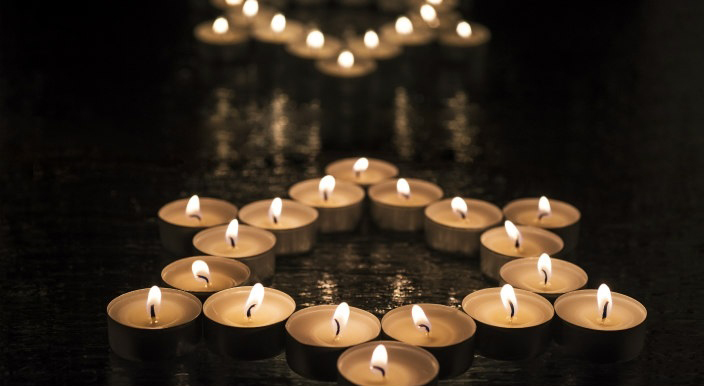
Featured Item

“It happened. I was there” – the stories of Holocaust survivors
When Pinchas Gutter, a Holocaust survivor who went on to live in South Africa, was liberated from the Theresienstadt Ghetto in Czechoslovakia in 1945, he was 13 years old and all alone.
His twin sister and parents had been murdered by the Nazis. However, soon after he was freed, he spotted two horses pulling a wagon and claimed them as his “family”.
He explained in a hologram question-and-answer session, “On the first day of my liberation, I went out and suddenly spied a wagon with two horses. I would have spent a lot of time with horses on my grandfather’s farm, so I loved horses. I started walking towards this wagon. I didn’t see anybody.” He pulled the reins of the horses, and they went where he directed them. “They became my family. They became my closest friends. They just became my life. I built a stall for them.”
The hologram session was held as part of the Yom Hashoah commemoration at the Johannesburg Holocaust & Genocide Centre on 26 April. It was jointly organised by the Union of Jewish Women South Africa and the Women’s International Zionist Organisation.
The hologram presentation was from the United States and recorded sometime over the past few years, said Brenda Trope, a volunteer educational guide at the centre.
Gutter’s family was extremely religious and living in Poland when the Nazis invaded in 1939. The Gutters then moved to Warsaw to escape and landed up becoming interred in the Warsaw Ghetto before being deported to the Majdanek concentration camp. It was there that Gutter’s parents and twin sister were murdered. He was marched to the Theresienstadt Ghetto and was liberated from there by the Red Army in 1945.
He went on to live in Paris, Israel, England, and South Africa before emigrating to Canada.
Trope started the commemoration by explaining that Yom Hashoah is a day of remembrance of the Holocaust. “It’s a day we pay tribute to and honour our survivors, their loss, and sorrow,” she said. “We remember with deep sorrow the death and destruction of our Jewish people by the Nazis on the soil of Europe from 1939 to 1945. Six million innocent beautiful souls perished. Among them were one and a half million beautiful Jewish children who were never able to reach their potential and they were killed for one reason only. They were Jewish.”
She said we should bear in mind that the Holocaust didn’t begin with gas chambers. “It began with dark, hateful, evil words, so we need to be mindful of our words and actions.”
Thereafter, a video from the centre told the story of the Holocaust and the reflections of survivors who went on to live in South Africa.
“I went to school in 1933,” said Gitta Rossi-Zalmons, one of those survivors. “I was just a simple kid in Germany. On the way home from school, I saw the brother of a friend of my mother and offered him a sweet. He said, ‘Not from you.’ I will never forget that answer, and I realised for the first time that this was going to be the new politics of our little town.”
World War II began on 1 September 1939. The Nazis first conquered Poland, then most of Europe and some countries in Africa.
Henia Bryer, born in Poland, said, “Everything changed immediately. The Jewish people, religious people, were the first target. They [the Nazis] used to catch them on the street, beat them up, and have them do the most terrible things in the streets.”
Irene Klass said, “My mother arranged with a teacher in the ghetto for me to have lessons. There were about five or six children in the group. We used to go every morning to a certain flat and get taught the basics. We were told that if there was a knock on the door or if we heard somebody coming, we must quickly hide the books under the beds because Jewish children aren’t allowed to learn.”
More than 52 000 forced labour and concentration camps were established in Europe and Africa. Shlomo Pieprz said, “They gave us the striped clothes and it was very cold in those clothes, and they gave us shoes from the people who got killed in Auschwitz.”
Thousands of Jews survived in hiding or with forged papers. Many were sheltered by Christians or Muslims at great personal risk.
Ascia Lieberman was hidden by a Lithuanian farmer. “For one year, we didn’t get out at all. The farmer was like an angel to us.”
After 1943, Germany began to lose the war. The Nazis attempted to kill as many Jews as possible. As the allied armies advanced, the retreating Nazis marched the prisoners on forced death marches into Germany. Thousands died.
Don Krausz, who survived a death march, said, “They marched us about 53km. This is the distance from Johannesburg to Pretoria. They shot anybody who couldn’t walk. We were stepping over the bodies that had been shot already.”
Two-thirds of European Jewry were dead by the war’s end in May 1945.
Said Krausz, “For years we had been thinking what we would do to the Nazi soldiers. But we were so weak, so demoralised, we didn’t touch them. We just let them go.”
Many people have wanted to take off Bryer’s tattoo of her Holocaust prison number. “Some doctors and plastic surgeons volunteered to take it off as a gesture. They didn’t even want me to pay for it. But I don’t want to take it off. It must remain. People are already saying these things never happened. I want them to see it happened. I was there.”










